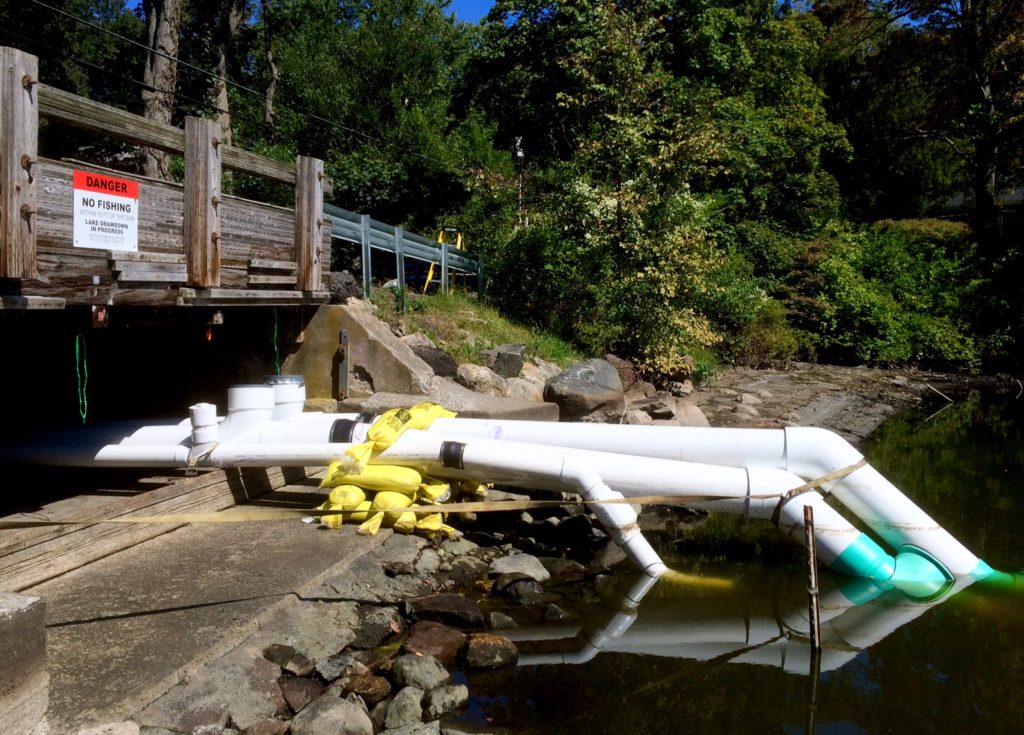The critical drawdown months are NOV & DEC and the target depth needs to be achieved before the ice-in freeze occurs in early December.
The full drawdown period each year is NOV – DEC – JAN – FEB.
Rainfall totals for drawdown critical months NOV – DEC:
8.4 inches – PRISM’s 30-year average rainfall for our area
(PRISM stands for Parameter-elevation Regressions on Independent Slopes Model and is the official spatial climate data developed by the NW Alliance for Computational Science & Engineering at Oregon State University in the early 1990s.)
- 13.9 inches – winter 2018 – above average/very wet
- 9.4 inches – winter 2019 – average
- 11.2 inches – winter 2020 – above average/wet
- 4.0 inches – winter 2021 – below average/dry
- 8.2 inches – winter 2022 – averageSiphon requirements:
Siphons must be installed in October and energized no later than November 1st each year that a drawdown is planned.
When James fabricates the siphons, we found out that the baffles to prevent whirlpools were not effective for that purpose.They can be left out. The three most important modification requirements are:
1.) Lengthen the siphons so that the three discharge elbows at the terminal ends extend all the way down to the river bed. The elbows need to rest on the river bed which first needs to be cleared of any loose stones and boulders. This is essential to ensure that the discharge ends are more than four feet lower in elevation than the intake ends, in order for the siphons to flow all the way to target depth. The river bed supports and stabilizes the massive weight of the longest portion of the water filled siphons.
2.) James will also extend the intake ends to lower them so that the top of the intake pipes are three to four feet below the concrete spillway ramp height.
3.) Fernco fittings need to be installed along the horizontal segments only. The siphons will separate if the Fernco fittings are installed in the inclined portions and supporting the heavy inclined water column.
Harold Ossher, our resident mathematician who moved to NC in March, was kind enough to revise his siphon and flow spreadsheet to calculate THREE 12′ siphons (increase from 2×12″ siphons plus one 6″ siphon) to be installed by James Gorman of P&LC and use PRISM 30-year average rainfall figures as well as increased rainfall contingencies.
Harold put the spreadsheet into Google, and here is the link: https://docs.google.com/spreadsheets/d/1B-nxpWpCp-0jVNMFHLQ8Cm7c02uMnYldTuokHpOtRAc/edit?usp=sharing. It contains his plain language conclusion and recommendations in bold print.
Please see his changes along with the seven lines he wrote from line #59 down within the tab A summary of the spreadsheet “Analysis – condensed.”
Note the nine spreadsheet tabs he created at the bottom if you are curious about the other data and calculation categories.
Remember, if the siphons are installed ON TOP of the weir boards, they must pull out 14 inches of lake water (about 30 million gallons) and rainfall (about 10 million gallons per day of rain) before drawdown officially begins when the lake reaches the concrete spillway ramp. Again, ice-in occurs every year before the second week in December, on average, so it is critical that the drawdown flow is energized before November 1st, through the three 12″ siphons, to reach target depth before the lake freezes – regardless of the rainfall amount or if the weir boards are removed or left in place for siphon support.
…Scot

2 x 12″ siphons installed in 2022 and prior years
Appendix: Ice and Rainfall history for Truesdale Lake drawdowns
Last year (2022-23 winter), the drawdown started a month too late. Officially, it was six weeks too late because the lake level didn’t reach the spillway’s concrete ramp until December 12th, then the siphons failed because the Fernco fittings were placed in the massively heavy and unsupported inclined intakes.
ICE-IN and ICE-OUT dates:
- ICE-IN ICE-OUT
- 12/27/2017 2/22/2018
- 11/21/2018 3/20/2019
- 12/08/2019 2/18/2020
- 12/19/2020 3/14/2021
- 12/21/2021 3/07/2022
- 12/22/2022 1/04/2023 (one month warm spell)
- & 2/4/2023 2/11/2023
Rainfall totals for drawdown critical months NOV – DEC:
- 8.4 inches – PRISM’s 30-year average rainfall for our area
- 13.9 inches – winter 2018 – above average/very wet
- 9.4 inches – winter 2019 – average
- 11.2 inches – winter 2020 – above average/wet
- 4.0 inches – winter 2021 – below average/dry
- 8.2 inches – winter 2022 – average
Rainfall totals for drawdown period months NOV – DEC – JAN – FEB:
- 15.3 inches – PRISM’s 30-year average rainfall for our area
- 22.7 inches – winter 2018 – above average/very wet
- 14.7 inches – winter 2019 – average
- 16.9 inches – winter 2020 – above average/wet
- 11.3 inches – winter 2021 – below average
- 14.8 inches – winter 2022 – average
